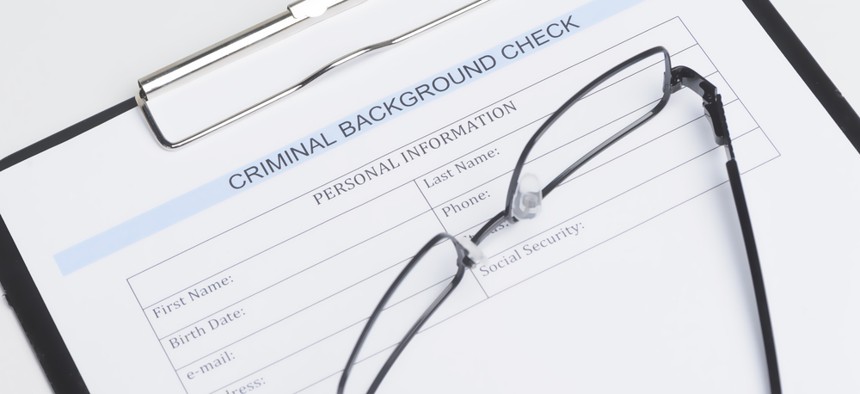
BlueSkyImage/Shutterstock.com
Precrime Comes to the Office
To weed out hires who might go on to misbehave, recruiters are relying on ethics questionnaires, personality tests, and credit histories. But can they truly anticipate misconduct?
As an indicator of a job candidate's virtues, the trio of a résumé, a cover letter, and an interview is rudimentary at best: Recruiters have been shown to spendabout six seconds pondering the average résumé, and those who formed positive impressions from certain candidates’ résumés have been shown to go softer on them in interviews. A hire is the result of a series of imperfect judgments.
The rewards of selecting a good employee are obvious; the harms of hiring a bad one are less commonly discussed. In the U.S., dishonest retail employees steal more from their employers every year than shoplifters do, and Kevin Murphy, now a professor of psychology at Penn State, once estimated that nearly a third of all failed businesses could be blamed on employee deviance. A recent reportfrom Cornerstone OnDemand, a company that sells software that helps employers recruit and retain workers, said that good employees are 54 percent more likely to quit when they start working closely with one who acts out.
If a single problem employee can wreak so much havoc, shouldn’t there be more of a focus on identifying better indicators of honesty? Some work has already been done in this area: Researchers have found that employees with certain personality traits, such as a propensity to feel guilt, and older employees are less likely to, say, slack off, abuse sick days, or steal company property.
But the arrival of Big Data in the workplace opens up the possibility of going beyond these sorts of general associations to individualized predictions.One 2011 paper proposed an eight-item questionnaire that has since been used in recruitment to predict a candidate’s future levels of “moral disengagement.” (Celia Moore, the paper’s lead author, intended it to be used to identify problematic work environments—"Bad behavior in organizations is always a combination of susceptible individuals and a poor organizational context," she says.) And a recent Cornerstone report demonstrated the importance of a single data point: People who overestimated their own technical proficiency in a job application were 43 percent more likely to engage in so-called toxic behavior.
Other work has shown how employees’ words can be reduced to numbers to serve the purposes of prediction. Paul Taylor, a professor of psychology at Lancaster University, was the lead author on a 2013 study that simulated a workplace with counterproductive employees. He and his fellow researchers offered certain subjects cash in exchange for smuggling corporate secrets to outside parties, and as all of the subjects went about their day as “coworkers,” the researchers monitored their communications.
“If a person is planning to act maliciously to damage their employer or sneak out commercially sensitive material,” Taylor later wrote, “the way they interact with their co-workers changes.” In Taylor's simulated workplace, employees on the verge of going rogue tended to use singular rather than plural pronouns and words with more negative connotations. When two communicators are in tune, they will typically mimic each others’ words as conversation unfolds—a way of telegraphing cooperation. But "toxic" employees, whether consciously or not, cut down on this mimicry so severely that this metric could be used to differentiate about 93 percent of harmful employees from their well-intentioned peers.
But trying to anticipate misbehavior has its limits. Several employers, from professional dog-walkers to 500-person corporations, for example, evaluate candidates’ credit reports alongside their résumés and cover letters. A bad credit report, the thinking goes, is a sign of financial irresponsibility, which in turn could be read as portending dishonesty on the job. In 2009, about 47 percent of Maryland companies polled by the state’s Society for Human Resource Management said they used credit reports to evaluate candidates for some positions. (13 percent used them for all applicants.) Today, the practice is legal in 40 states.
The problem with using credit reports to make a hiring decision is that there’s no empirical reason to believe they can predict success on the job. A 2012 studytested the logic of shunning bad credit by examining the original job applications of 178 employees at six different companies—60 of whom had gone on to get fired for misbehavior. The researchers found that a poor credit history was mostly useless in predicting whether an applicant would go on to get sacked. (The logic of credit reports unravels further when one considers that they are often riddled with errors, and that bad credit can just as often be due to outside circumstances—a death, a divorce—as to inherent irresponsibility.)
The takeaway, then, is not that résumés should be disregarded because they’re imperfect, or that Big Data is useless because it has flaws. It’s that selecting an employee through any means is inevitably a process with potholes.
(Image via BlueSkyImage/Shutterstock.com)






